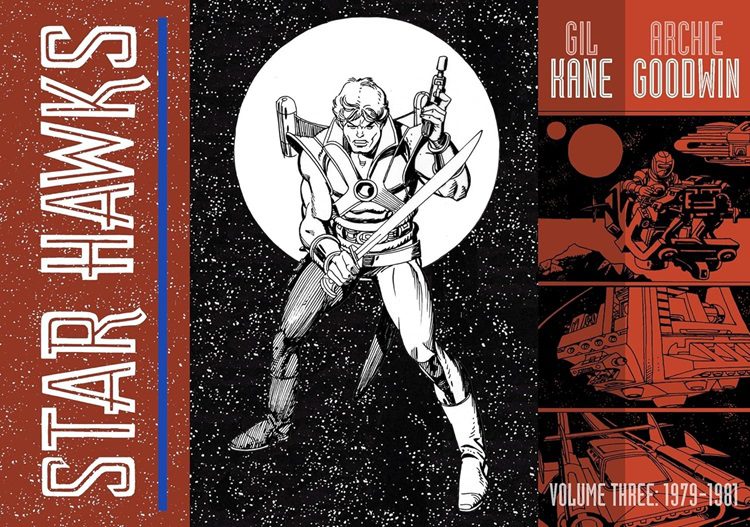
Star Hawks was a science fiction/fantasy daily newspaper comic strip that ran from 1977 to 1981. It tried to ride the coattails of movies like Star Wars and Star Trek, capturing their popularity and moving it to the daily papers. It was creatively drawn by Gil Kane and contained many a swashbuckling, alien-fighting, action-packed story. However, it always struggled to find an audience and once Star Wars and Star Trek moved into the daily papers themselves, it never stood a chance. Popular strips at this time were carried in hundreds of newspapers while Star Hawks could count the number of newspapers they were carried in on their fingers and toes.
Due to the increasing pressure of landing more newspapers to carry them and the constant threat of being taken over by bigger, similarly themed strips, United Features, Star Hawks syndicate, pushed for sweeping changes in the strip. Starting In March of 1979 (as seen in Star Hawks, Volume Two), head writer Ron Goulart was replaced by Archie Goodwin, a veteran writer and editor for both Marvel and DC. He quickly weaned out some of Goulart’s more sexist tendencies, keeping the heroes constantly in action with little time for dalliances with the ladies. His writing was darker too, a forerunner to the grim and gritty themes comics would take on in the 1980s.
Goulart had copyrighted much of the background aspects of the Star Hawks scripts including the entire Barnum star system the comic took place in. With him gone, that system had to be eradicated so they just blew it up. Many of the secondary characters were dropped as well and a new roster added, including Operations Chief Lhasa, a reptilian science officer, and a vegan tree imp.
By the dawn of the 1980s, the strip’s two-tiered panel, which enabled Gil Kane to get really creative with his art, was dropped for a more typical one-tier style. Star Hawks simply wasn’t popular enough to convince newspapers to give up that much real estate. The strip suffers for it. It is difficult enough to tell a fully dramatic story in two tiers, when its dropped to one, leaving basically three squares a day, it’s nearly impossible. The art had to become much more conventional as well.
Having all the strips combined into one book alleviates a lot of those troubles as we don’t have to wait a day for another strip, and can read it all in one setting, but the necessities of constantly reminding the original readers of where things sit slows things down considerably. This isn’t a sole Star Hawks problem, but one that comes with any newspaper strip trying to tell a continuous story. Goodwin does his best to keep things moving so even if you aren’t current on the story you’ll get caught up in the action. There is hardly a panel that isn’t either preparing for action, filled with action, or dealing with the aftermaths of the previous action. It all moves so quickly you are left breathless after a few pages.
Archie Goodwin likewise fills the limited space as creatively as possible. With all the changes, he had to invent new planets, new ships, and new characters. Little of it is completely invented, even minor fans of the genre will see similarities to other science-fiction franchises. But he draws them well with plenty of drama coming just from the art. He’s a master of shadow and light, creating distinctive panels using the darkness of space as an ever inventive backdrop.
It is a shame Star Hawks never drew a big audience. It was an inventive strip, utilizing a rarely seen two-tiered panel system to create eye-catching stories and fantastic art from Gil Kane. This third and final book in the series from the Library of American Comics is a bit of a come down due to restrictions created by the syndicate due to poor sales. Knocking it back to one tier inhibits Kane’s art and the story changes necessitated by the departure of Ron Goulart are like a one-two punch. Still, there is plenty to enjoy and if you are a fan of action-packed sci-fi comic strips, then this comes highly recommended.
As always the Library of American Comics presents Star Hawks, Volume Three: 1979-1981 in the best possible manner. It comes in a beautiful hardback book with the strips reprinted from the best possible sources and an informative introductory essay.